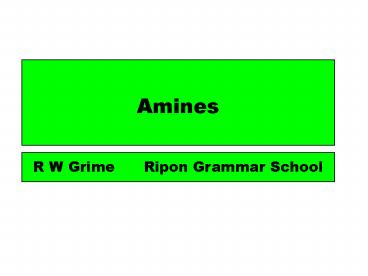Amines - PowerPoint PPT Presentation
1 / 23
Title:
Amines
Description:
4.7.0 TYPES OF AMINES. Aromatic amines have the N joined to the benzene ... 4.7.3 MAKING ALIPHATIC 1y AMINES. 4.7.3 MAKING ALIPHATIC 1y AMINES. Butylamine ... – PowerPoint PPT presentation
Number of Views:156
Avg rating:3.0/5.0
Title: Amines
1
Amines
R W Grime Ripon Grammar School
2
4.7.0 TYPES OF AMINES
NOT AMINES
3
4.7.0 TYPES OF AMINES
NOT AMINES
4
4.7.0 TYPES OF AMINES
- There is some H-bonding between 1y and 2y amines.
- Quaternary ammonium salts are not amines.
- Aromatic amines have the N joined to the benzene
ring, e.g. phenylamine.
5
4.7.1 BASE STRENGTH OF AMINES
- Amines are weak bases.
- Lone pair on N can accept a proton.
- Base strength depends on how well N lone pair can
accept H. - The higher the electron density of the N lone
pair, the stronger the base.
6
4.7.1 BASE STRENGTH OF AMINES
methylamine nitric acid
diethylamine sulphuric acid
7
4.7.1 BASE STRENGTH OF AMINES
- Alkyl groups push electrons towards the N better
than H (remember carbocation stability).
Stability increases
8
4.7.1 BASE STRENGTH OF AMINES
- Alkyl groups push electrons towards the N better
than H (remember carbocation stability).
Base strength increases
3y gt 2y gt 1y gt NH3
9
4.7.1 BASE STRENGTH OF AMINES
- In aromatic amines, the N lone pair is partially
delocalised into the benzene ring, lowering the
base strength.
3y gt 2y gt 1y gt NH3 gt aromatic
10
4.7.1 BASE STRENGTH OF AMINES
methylamine
diethylamine
Stronger base diethylamine
- 2Y compared to 1Y
- Diethylamine has greater electron density on N
lone pair - Diethylamine has greater ability to accept H
11
4.7.1 BASE STRENGTH OF AMINES
propylamine
phenylamine
Stronger base propylamine
- Lone pair on phenylamine N is partially
delocalised into benzene ring - Propylamine has greater electron density on N
lone pair - Propylamine has greater ability to accept H
12
4.7.1 BASE STRENGTH OF AMINES
ammonia
phenylmethylamine
Stronger base phenylmethylamine
- 1Y compared to ammonia
- Phenylmethylamine has greater electron density on
N lone pair - Phenylmethylamine has greater ability to accept
H
13
4.7.1 BASE STRENGTH OF AMINES
ammonia
cyclohexylamine
Stronger base cyclohexylamine
- 1Y compared to ammonia
- Cyclohexylamine has greater electron density on N
lone pair - Cyclohexylamine has greater ability to accept H
14
4.7.2 NUCLEOPHILIC SUBSTITUTION
- Met in Module 3 (reaction of haloalkanes NH3).
- Lone pair on N can attack ? C of haloalkane.
-
NH4X
15
4.7.2 NUCLEOPHILIC SUBSTITUTION
- H on N is swapped by R from haloalkane.
- Product also has lone pair on N so product reacts
further.
- To get mainly 1y amine use XS NH3.
- To get mainly 4y ammonium salt use XS RX.
16
4.7.2 NUCLEOPHILIC SUBSTITUTION
methylamine chloroethane (products 1st
mechanism)
17
4.7.2 NUCLEOPHILIC SUBSTITUTION
diethylamine 2-bromopropane (products)
18
4.7.2 NUCLEOPHILIC SUBSTITUTION
Soaps, e.g.
ionic head (hydrophylic) dissolves in water
long alkyl tail (hydrophobic) dissolves grease
Detergents, e.g.
19
4.7.2 NUCLEOPHILIC SUBSTITUTION
20
4.7.2 NUCLEOPHILIC SUBSTITUTION
4y ammonium salts
- Ones with some long chain alkyl groups can be
used as cationic surfactants. - Often used in fabric softener as many fabrics
have ve charge on surface.
e.g. (CH3)2N(CH2)16CH32 Cl-
21
4.7.3 MAKING ALIPHATIC 1y AMINES
1 Reaction of NH3 with haloalkanes
- Need to separate mixture of products.
2 Reduction of nitrile compounds
22
4.7.3 MAKING ALIPHATIC 1y AMINES
Butylamine
a) CH3CH2CH2CH2Cl 2 NH3 ? CH3CH2CH2CH2NH2
NH4Cl
- CH3CH2CH2Cl KCN ? CH3CH2CH2CN KCl
- CH3CH2CH2CN 4 H ? CH3CH2CH2CH2NH2
23
4.7.3 MAKING AROMATIC AMINES































